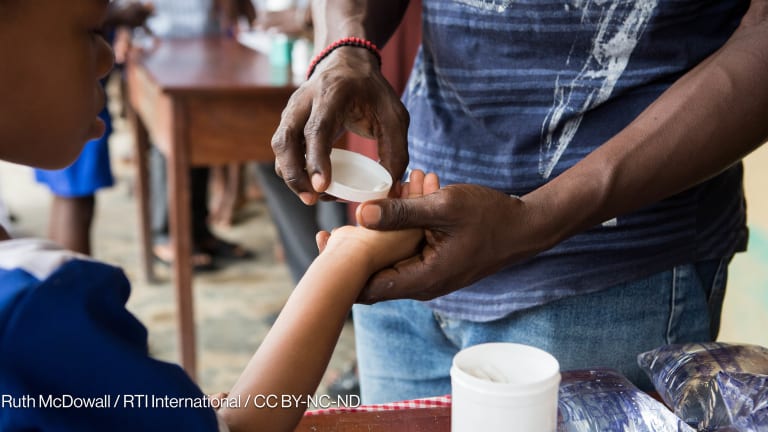
This World Malaria Day provides an occasion to acknowledge the achievements made in rolling back the disease over the last 30 years. It is also an opportunity for a reality check.
For all the progress made, if we are to actually transform the rhetoric of “ending malaria for good” into reality, we must harness the unfulfilled potential of innovation and research to eliminate this age-old scourge. Political leaders in Europe and the United States need to embrace the pivotal role Research and Development can play in the fight against malaria — and the global health community needs to help them understand the transformative potential of investing in health research at home and abroad. Governments on both sides of the Atlantic need to act, putting their political and financial support behind the innovative solutions necessary to end the epidemic of malaria by 2030.
We’ve made progress — but there’s much more to be had
Enormous progress has been made in rolling back malaria; since 2001, an estimated 6.8 million malaria-related deaths have been averted. The incidence of malaria in at-risk populations dropped 21 percent globally, and mortality rates have fallen by 29 percent since 2010, thanks to effective malaria prevention and treatment programmes. However, the disease remains stubbornly prevalent across the world, and still has a foothold in 91 countries. What’s more, growing drug and insecticide resistance threatens to unravel progress we have made, and complicate efforts to eliminate the disease. If we are serious about ending malaria for good, we need a diverse arsenal of new tools, including new preventive measures, rapid, affordable diagnostic tools, better treatments, and an effective vaccine.
See related topics:
► What you need to know from the 2016 World Malaria Report
► Gates Foundation shapes investments to 'accelerate to zero' on malaria
► Opinion: Smallpox eradication strategy should be used for measles, rubella
But developing these tools requires strong, sustained investment, and right now, funding from donor governments is failing to match ambition and need. The $565 million spent on malaria research in 2015 (the last year for which there is GFinder reporting) marked the sixth year in succession where total malaria funding has remained below its 2009 peak. As with overall global health R&D funding, stagnating and insufficient research funding for malaria will hinder our ability to achieve the Global Goals by 2030. What’s more, it is a missed opportunity: Global health R&D delivers results.
Malaria R&D is delivering results
Politicians in Europe and the U.S. need to know that investments in global health R&D deliver significant returns, both in lives saved and economic impact. A recent Lancet study recommended spending $6 billion annually by 2020 on global health research — half of what malaria costs African economies each year. What’s more, malaria consumes 25 percent of household income in high-burden areas, due to lost productivity and health care related expenses. It puts a huge strain on already precarious public health systems. Government investments in global health research has a clear track record in job creation at home and abroad — 10,000 new jobs in Europe and 200,000 in the U.S. since 2007. European Union programmes such as the European and Developing Countries Clinical Trials Partnership and the Fogarty International Center at the U.S. National Institutes of Health have helped train a new generation of researchers in sub-Saharan Africa. Funding for malaria is also leading to innovative new treatments. New first-of-their-kind, child-friendly malaria medicines have helped cut childhood malaria deaths by 65 percent since 2000, and the world’s most advanced malaria vaccine candidate will soon begin pilot implementation by the World Health Organization in sub-Saharan Africa. Convincing governments that global health R&D delivers tangible results is one thing. To truly make an impact, we need them to act.
It’s up to donor governments to unlock financing
Increasing investment is the first step to accelerating malaria research. In Europe, the Imagine2030 campaign has been calling for the EU to increase funding closer to the 0.01 percent of GDP on disease research recommended by a WHO consultative body. In 2017 and 2018, the EU will review its existing commitments to research, and launch discussions on priorities for its next multi-year budget cycle starting in 2020 — they need to seize this opportunity to act. In the U.S., proposed cuts to foreign assistance and medical research threaten to stifle global health innovation, endanger the lives of people around the world including Americans, and hurt the U.S. economy. At a time when global disease threats are on the rise and promising new innovations are in development, U.S. policymakers should reassert American leadership in global health innovation and increase funding, not pull back support.
Money alone is not enough. Innovation is not only needed in the laboratory, but also in how we fund research. This means governments supporting mechanisms and partnerships that bring together all actors — public and private — to collaborate on translating research into new tools and making sure that these tools are accessible for the people that most need them.
If, collectively, we can achieve these three steps — embrace innovation as key to the fight against malaria, understand the transformative impact of R&D investment, and act to mobilize resources and support for disease research — we will be closer to fulfilling the campaign message for World Malaria Day: ending malaria for good. Let’s get on with it.
For more Devex coverage on global health, visit Focus On: Global Health









